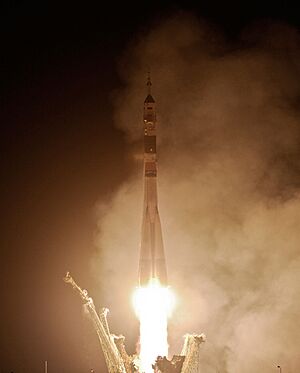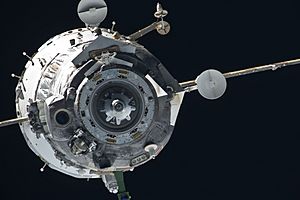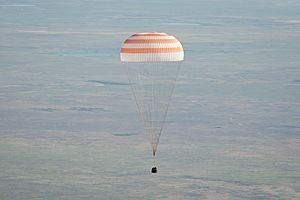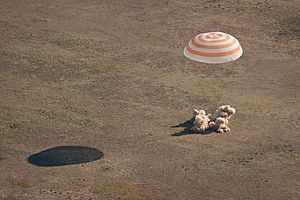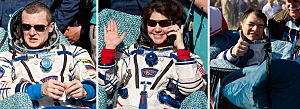Soyuz TMA-20 facts for kids
| Operator | Roscosmos |
|---|---|
| Mission duration | 159 days, 7 hours, 17 minutes, |
| Spacecraft properties | |
| Spacecraft type | Soyuz-TMA 11F732 |
| Manufacturer | RKK Energia |
| Crew | |
| Crew size | 3 |
| Members | Dmitri Kondratyev Catherine Coleman Paolo Nespoli |
| Callsign | Варяг ("Varangian") |
| Start of mission | |
| Launch date | December 15, 2010, 19:09 UTC |
| Rocket | Soyuz-FG |
| Launch site | Baikonur 1/5 |
| End of mission | |
| Landing date | May 24, 2011, 02:27 UTC |
| Orbital parameters | |
| Reference system | Geocentric |
| Regime | Low Earth |
| Docking with ISS | |
| Docking port | Rassvet nadir |
| Docking date | 17 December 2010 20:12 UTC |
| Undocking date | 23 May 2011 21:35 UTC |
| Time docked | 157d 1h 23m |
  From left to right: Coleman, Kondratyev and Nespoli Soyuz programme
(Crewed missions) |
|
The Soyuz TMA-20 was a special spacecraft that carried people to the International Space Station (ISS). It was part of the Soyuz programme, which is a big space program.
This mission started on December 15, 2010, when the spacecraft launched from Baikonur Cosmodrome in Kazakhstan. Two days later, it safely connected with the ISS. The crew of Soyuz TMA-20 had three astronauts: Dmitri Kondratyev, Catherine Coleman, and Paolo Nespoli. They came from different space agencies: Roscosmos (Russia), NASA (USA), and the European Space Agency (ESA).
These three astronauts were half of the team for Expedition 27 on the ISS. The other three crew members arrived later on another spacecraft called Soyuz TMA-21. After spending 159 days in space, the Soyuz TMA-20 spacecraft returned to Earth. It landed safely in Zhezkazgan, Kazakhstan, on May 24, 2011.
Contents
Meet the Crew

NASA officially announced the crew for Soyuz TMA-20 on November 21, 2008.
| Position | Crew Member | |
|---|---|---|
| Commander | Expedition 26 Only spaceflight |
|
| Flight Engineer 1 | Expedition 26 Third and last spaceflight |
|
| Flight Engineer 2 | Expedition 26 Second spaceflight |
|
Backup Crew Members
Sometimes, a backup crew is ready in case the main crew cannot fly. Here were the backup astronauts for this mission:
| Position | Crew Member | |
|---|---|---|
| Commander | ||
| Flight Engineer 1 | ||
| Flight Engineer 2 | ||
Tallest Astronaut on Soyuz
European astronaut Paolo Nespoli was thought to be the tallest person to ever fly on a Soyuz spacecraft. He is 188 centimeters (6 feet 2 inches) tall. Because of his height, a special seat and other equipment had to be built just for him. This was confirmed by Vitaly Lopota, the president of RKK Energia, which makes the Soyuz spacecraft.
Spacecraft Damage
The Soyuz spacecraft had some damage during its trip to the Baikonur Cosmodrome. This happened on October 5, 2010. Engineers found the damage after the spacecraft was shipped by train from Russia to Kazakhstan.
At first, it was not clear if the spacecraft would need to go back to the factory in Moscow. But later, Russian officials decided to replace the damaged part. They flew a new part, called the descent module, to Baikonur on a cargo plane. This new module was originally meant for the Soyuz TMA-21 spacecraft.
Even with the damage, Vitaly Lopota from RKK Energia said the mission would still happen in December. A spokesman for Roscosmos, Alexander Vorobyov, also said the launch date would not change. He mentioned that a spare spacecraft was available if needed.
Launching and Docking
The Launch
On December 12, 2010, the Soyuz TMA-20 spacecraft was put together with its rocket, the Soyuz FG. The emergency escape system was also attached. This meant the mission was fully ready to go. The rocket was then moved to the launch pad on the morning of December 13, 2010.
Soyuz TMA-20 blasted off from Baikonur Cosmodrome at 7:09 PM GMT on December 15, 2010. It reached orbit successfully about ten minutes later.
Connecting to the ISS
The Soyuz TMA-20 spacecraft connected with the Rassvet module on the ISS at 8:12 PM GMT on December 17, 2010. This connection happened while the space station was flying over western Africa, about 224 miles above Earth.
To get ready for docking, the Soyuz TMA-20 started its automatic meeting process around 5:49 PM GMT. The spacecraft's engines fired at 6:09 PM GMT, and again around 6:28 PM GMT. Soon after, the Kurs system on both the Soyuz and the ISS turned on to help them connect. A camera on the front of the Soyuz spacecraft was turned on at 7:29 PM GMT. This camera showed live views of the docking.
After making sure there were no leaks between the two spacecraft, the hatch (door) between Soyuz TMA-20 and the space station opened at 11:02 PM GMT. A welcome ceremony was held shortly after the new crew came aboard. This was shown live on television.
Leaving and Landing
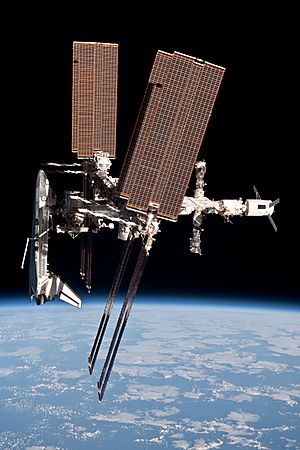
This was a textbook entry for Dmitry Kondratyev, Paolo Nespoli and Cady Coleman. "All of the functions of the Soyuz TMA-20 were by the book, no issues reported. – NASA MCC Commentator Rob Navias
After spending 157 days connected to the ISS, the Soyuz TMA-20 spacecraft undocked. This happened at 9:35 PM UTC on May 23, 2011. Russian cosmonaut Dmitri Kondratyev was in control. The ISS was flying over eastern China at that time. Kondratyev sat in the middle, with NASA astronaut Catherine Coleman on his right and ESA astronaut Paolo Nespoli on his left.
Kondratyev moved the spacecraft about 600 feet away from the ISS. He then stopped to let Nespoli take pictures. About 15 minutes after undocking, Nespoli took many photos and videos of the station. He also captured the Space Shuttle Endeavour, which was docked to the ISS for its last mission, STS-134. The door between the Soyuz's parts was opened for the photo shoot. Nespoli took pictures through a window. At 9:55 PM UTC, the ISS slowly turned. This gave Nespoli the best light and a side view of Endeavour.
Nespoli spent about 25 minutes taking pictures. Then, he took the digital photo memory cards from his cameras. He went back into the Soyuz's main part where the crew sits. Once Nespoli was strapped into his seat, the door was closed. The Soyuz spacecraft then fired its engines at 10:15 PM UTC. This made it move further away from the ISS.
Flying over the southern Atlantic Ocean, the Soyuz fired its engines again at 1:36 AM UTC on May 24. This burn lasted for four minutes and 16 seconds. The different parts of the spacecraft separated at 2:01 AM UTC. The part with the crew inside reached Earth's atmosphere at about 62 miles high, at 2:03 AM UTC.
The return to Earth went smoothly. The weather was sunny and warm, unlike the very cold conditions during the previous Soyuz TMA-01M landing. The Soyuz TMA-20's large parachute and smaller drogue chute opened as planned. The spacecraft came down towards its landing spot near Dzhezkazgan in Kazakhstan. Russian rescue teams watched the landing. They used three Antonov planes, 14 Mi-8 helicopters, and seven rescue vehicles. NASA TV showed live video of the landing.
The Soyuz TMA-20 spacecraft landed safely upright at 2:27 AM UTC on May 24, 2011. The mission had lasted for 159 days, seven hours, and 17 minutes. Russian rescue teams helped the crew. U.S. and Russian doctors were also there. Kondratyev and Coleman looked well. They were smiling and talking with the support staff. They even shared a satellite phone to call their families. However, at a press conference, Vyacheslav Rogozhkin said that Nespoli had a small issue with his balance system.
The crew was flown from the landing site to Karaganda for medical checks. In Karaganda, Coleman and Nespoli boarded a NASA jet. They flew back to NASA's Johnson Space Center in Houston. Kondratyev flew on a Russian plane back to Chkalovsky Airport near the Gagarin Cosmonaut Training Center.
See also
 In Spanish: Soyuz TMA-20 para niños
In Spanish: Soyuz TMA-20 para niños


